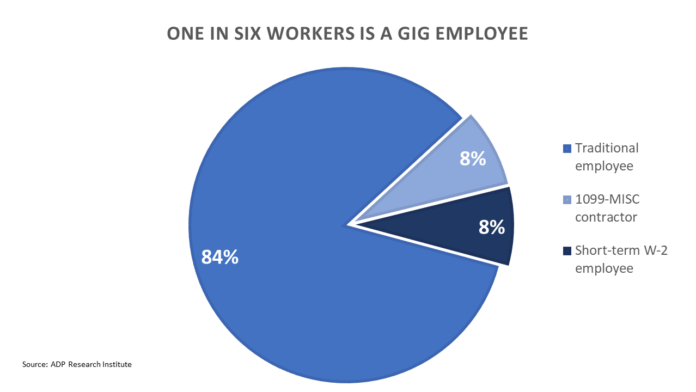It may come as little surprise to HR leaders that so-called gig work continues to rise. Most importantly, though, that growth spurt is driving employer demand for skilled talent, according to a new research report.
The report from the ADP Research Institute, titled Illuminating the Shadow Workforce: Insights into the Gig Workforce in Businesses, found that, from 2010 to 2019, the share of gig workers in businesses increased by 15%, with both short-term W-2 and 1099-M gig workers contributing equally to the uptick.
The report–fueled by anonymized payroll data of 18 million workers from 75,000 companies, coupled with 16,800 direct survey responses from traditional employees and gig workers (and 21 C-level executive interviews)–also reveals tenured workers and retirees are capitalizing on the tight U.S. labor market and the need for skilled workers by turning to gig work.
Ahu Yildirmaz, co-head of the ADP Research Institute, says the research shows that this changing workforce composition has significant talent management, budget and compliance implications for businesses of all sizes.
“It is clear there is a fundamental shift in the workforce as innovation continues to transform work, increasing the demand for skilled workers,” said Yildirmaz during a recent webinar. She added that, in order to bridge the talent gap in today’s particularly tight labor market, many companies are hiring skilled workers at a premium.
The ADP Research Institute study identified two worlds of gig workers: One entails 1099-M contractors who are independent, often hired for their skills on a project basis. These workers tend to be older, highly educated and choose to work on what they enjoy. In fact, 30% of 1099-M gig workers are 55 or older. For some, their gig work is supplemental income to retirement savings. The second group includes short-term W-2 employees, who are often younger, less educated, have a lower income and are typically working on a seasonal or on-call basis.
The report found one in six enterprise workers is actually a gig worker paid as either a 1099-M worker or a short-term W-2 employee, working one to six months.
Among other findings:
- Every industry relies on gig workers. Recreation, construction and business services are the top three industries utilizing the gig workforce.
- More than half of the 1099-M contractors work for the same company for 12 consecutive months, just like any traditional W-2 employee.
- Earning potential is similar to traditional workers. The average income for gig employees working for 12 consecutive months is similar, regardless of being a 1099-M worker or a traditional W-2 employee.
The research predicts gig work will continue to grow, and that means an increasing impact on workforce dynamics, forcing companies to optimize talent management and workforce strategy. For example, 60% percent of 1099-M gig workers say they will continue to gig for the next three years.
Yildirmaz says that while the term “gig worker” has seamlessly integrated into our vernacular and culture, until now there has been no real data-driven insight into the gig workforce in the enterprise space. She adds that this “shadow workforce” is comprised of workers with vast skill sets, who work across all industries and in all regions of the U.S.
“Additionally, we found that the majority of these workers are doing gig work out of preference,” she said.
In fact, the research found that more than 70% of 1099-M gig workers say they are working independently by their own choice, not because they can’t find a “traditional” job. Most seem happy with gig work and place a premium on flexibility as a driving motivation behind their decision, over financial security or benefits. Of millennials and Gen Z workers (under the age of 34) surveyed, 74% say they would continue to work as a 1099-M worker–even if they lost their current health insurance.



